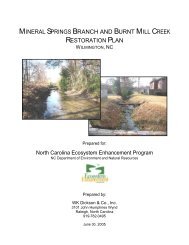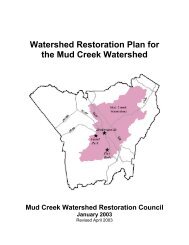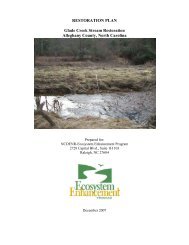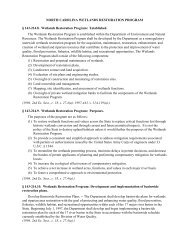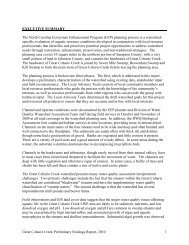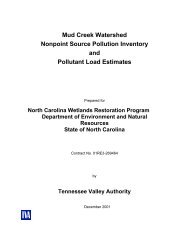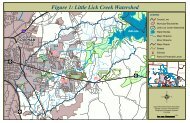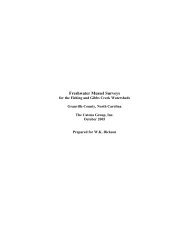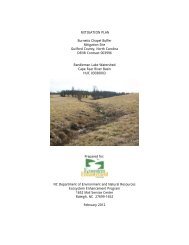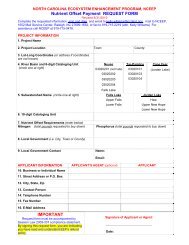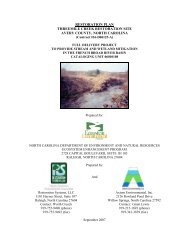Watershed Restoration Plan for the White Oak River Basin i
Watershed Restoration Plan for the White Oak River Basin i
Watershed Restoration Plan for the White Oak River Basin i
Create successful ePaper yourself
Turn your PDF publications into a flip-book with our unique Google optimized e-Paper software.
SECTION 3: RESTORATION GOALS FOR THE WHITE OAK RIVER BASIN<br />
Based on an assessment of existing watershed characteristics and resource in<strong>for</strong>mation, <strong>the</strong><br />
NCWRP has developed three broad restoration goals <strong>for</strong> <strong>the</strong> <strong>White</strong> <strong>Oak</strong> <strong>River</strong> <strong>Basin</strong>. Each goal<br />
reflects <strong>the</strong> NCWRP’s watershed restoration strategy to focus restoration projects within local<br />
watersheds in order to address water quality impacts from nonpoint source pollution. The goals<br />
also reflect <strong>the</strong> NCWRP's focus on restoring wetland and riparian area values such as<br />
maintaining and enhancing water quality, increasing storage of floodwaters, and improving fish<br />
and wildlife habitat. The general restoration goals <strong>for</strong> <strong>the</strong> <strong>White</strong> <strong>Oak</strong> <strong>River</strong> <strong>Basin</strong> are listed<br />
below, including specific objectives <strong>for</strong> reaching those goals.<br />
1. Protect and improve water quality throughout <strong>the</strong> <strong>Basin</strong> by reducing sediment and<br />
nutrient inputs into streams and rivers.<br />
- Implement stream restoration projects that reduce<br />
instream sources of sediment pollution by stabilizing<br />
streambanks and restoring channel meanders, especially in<br />
headwater tributaries and upper portions of rivers.<br />
- Restore riparian vegetation and wetlands to trap<br />
sediment pollution and remove nutrients from surface<br />
runoff.<br />
- Work with local land trusts and landowners to protect<br />
in perpetuity high-quality watersheds through restoration<br />
and preservation of critical riparian and wetland tracts.<br />
- Support <strong>the</strong> education/outreach ef<strong>for</strong>ts of local Cooperative Extension Service and Soil &<br />
Water District staff, especially in <strong>the</strong> areas of agricultural, residential and urban stormwater<br />
BMPs.<br />
2. Protect shellfish harvesting waters and reduce <strong>the</strong> number & frequency of Division of<br />
Environmental Health (DEH) closures of designated shellfish growing areas.<br />
- Support local studies of <strong>the</strong> sources of fecal coli<strong>for</strong>m<br />
bacteria and <strong>the</strong> development of strategies <strong>for</strong> reducing<br />
fecal coli<strong>for</strong>m inputs into local waters-- including urban<br />
stormwater BMPs.<br />
- Implement stream, wetland and riparian buffer restoration<br />
projects within watersheds that drain directly into class SA<br />
waters [e.g., tidal creeks].<br />
- Support local public education/outreach ef<strong>for</strong>ts to increase<br />
public awareness of <strong>the</strong> sources and controls of pathogens<br />
in local streams, rivers, bays and sounds.<br />
<strong>Watershed</strong> <strong>Restoration</strong> <strong>Plan</strong> <strong>for</strong> <strong>the</strong> <strong>White</strong> <strong>Oak</strong> <strong>River</strong> <strong>Basin</strong> 13




